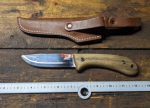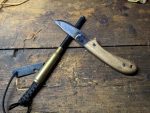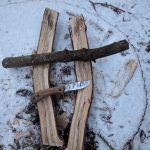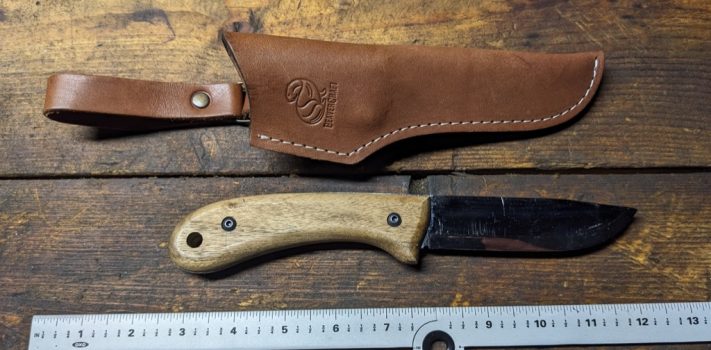The Ukrainian-made BeaverCraft Glacier Bushcraft Knife has a razor-sharp, 4.25-inch, full-tang, Scandi-grind blade made of 1066 high carbon steel. The blade is 1.18 inches wide, and 0.13 inches thick at the base.
The knife is 10.63 inches overall in length, with an unfinished European walnut handle. It comes with a nice leather dangler-form sheath.
Although 1066 steel is not highly corrosion resistant, I did not experience any problems with rust throughout the testing period even though I used the knife under a wide variety of inclement weather conditions.
With a price at the time of writing of $45 at beavercrafttools.com, the knife represents a good value for the money. If you need a highly functional and attractive knife and sheath combination at a reasonable price, the BeaverCraft Glacier Bushcraft Knife might be a good choice.
Background
It was Christmas Eve 2023. Our family celebrations were scheduled for later in the week, so my wife “Kari” and I were enjoying a quiet evening at home.
Kari had gone to bed early, and I was surfing the web a little before I settled down for a long winter’s nap.
As I surfed the web, I ran across a reference to BeaverCraft Bushcraft Knives. They looked like good solid knives. The fact that they are made in the Ukraine made them particularly interesting, since I had never reviewed a Ukrainian-made product before. I sent BeaverCraft an email message asking if they could provide me with a sample for testing and evaluation. Several days later I received a response. BeaverCraft was kind enough to agree. Eventually, I received a padded envelope via USPS from BeaverCraft Group LLC, 2010 Broening Hwy, Baltimore, MD 21224.
First Impressions
The nicely printed paperboard box measured approximately 10.5 x 2.38 x 1.88 inches. The box was imprinted with pictures of the knife, a number of BeaverCraft logos, a UPC symbol, various other information, and the words, “If your product does not perform properly, please contact us at returns@beavercrafttools.com for a replacement.”
I opened the product box and removed the knife, sheath, and lanyard.
 The leather dangler-form sheath has the BeaverCraft logo stamped into the leather. The stitching is not quite as heavy as I might like, but the handiwork on the sheath was otherwise very tidy and workmanlike. The quality of the leather was also quite good, and it was of an appropriate gauge. The blade arrived quite oily, which is appropriate for a high carbon blade while in storage or during shipment. The blade is nicely polished, with the BeaverCraft logo laser etched on the left side. It came out of the box very smoothly shaving sharp. Whoever sharpens blades for BeaverCraft does an excellent job.
The leather dangler-form sheath has the BeaverCraft logo stamped into the leather. The stitching is not quite as heavy as I might like, but the handiwork on the sheath was otherwise very tidy and workmanlike. The quality of the leather was also quite good, and it was of an appropriate gauge. The blade arrived quite oily, which is appropriate for a high carbon blade while in storage or during shipment. The blade is nicely polished, with the BeaverCraft logo laser etched on the left side. It came out of the box very smoothly shaving sharp. Whoever sharpens blades for BeaverCraft does an excellent job.
The European walnut grips are held on by 2 hex-headed, binding-barrel-and-screw sets. There is also a hole in the handle for the included paracord lanyard. The shape of the handle conforms well to the hand, and is comfortable during use.
The unfinished grips are somewhat poorly sanded in places with visible tool marks remaining on the wood. Although this moderately rough and unfinished surface lacks some eye appeal, it provides an excellent grip surface. If this was my primary knife, I would probably smooth the grips with some fine sandpaper, and then finish them with boiled linseed oil. The finished product would probably look and feel much nicer, but not function quite as well.
Testing
I attached the sheath and the knife it contained to the belt of my work pants, and began to carry them whenever I was outside working around the property.
Over the course of more than a month of regular use, I applied the knife to a variety of routine tasks, which included the following:
- hacking small branches off of rounds that I was preparing to split into firewood.
- cutting open a plastic bag containing a tarp, so that I could use the tarp to cover a completed wood stack.
- cutting paracord to secure the tarp to the completed wood stack.
- smoothing rough spots on the side of a drawer. The rough spots were interfering with the installation of a new drawer rail.
- cutting cable ties that were holding wires to an unused junction box that I was removing from the side of the house.
- prying up the edges of cement pavers so that I could get my fingers under them to remove them.

 The knife performed well at all of these tasks and a host of others, as well. I also tested how well the back of the blade struck sparks with a ferrocerium rod. Its performance was wholly satisfactory. Finally, I used the blade to baton a rather twisted and gnarly small billet of wood. The knife was robust enough to complete this task with ease.
The knife performed well at all of these tasks and a host of others, as well. I also tested how well the back of the blade struck sparks with a ferrocerium rod. Its performance was wholly satisfactory. Finally, I used the blade to baton a rather twisted and gnarly small billet of wood. The knife was robust enough to complete this task with ease.
It was necessary for me to lay prone while performing certain jobs during the month. When this occurred, I found that the knife, like most other sheath knives, was not particularly comfortable to have between me and the ground. The dangler-form sheath made it easy to move the knife out of the way, but it did nothing to prevent the knife from getting in the way in the first place.
The highly polished surface of the blade was easily scratched during use, and the scratches showed up quite distinctly on the highly reflective background. A bead blasted, stonewashed or other more subdued finish would probably mask marks of use more effectively without significantly increasing production costs.
All in all, I was satisfied with the performance of the knife throughout the testing period.
Corrosion Resistance
A knife made out of 1066 high carbon steel will require a certain amount of care during field use or long storage. If the blade is not kept well-oiled, the knife may corrode.
The 1066 steel is composed of approximately 97.5% iron, 1.1% manganese, 0.7% carbon, 0.38% silicon, 0.25% chromium, 0.05% sulfur, and 0.04% phosphorus. The carbon makes the alloy harder, but also creates compounds within the metal that interact electrically in the presence of water to produce rust.
There was a time when most knives were made out of high carbon steel. It takes and holds an edge well. Now that many knives are made out of more-corrosion-resistant steels, users tend to be less attentive to blade care than they were in the past. This BeaverCraft knife may be less forgiving of such inattention than many other contemporary knives.
BeaverCraft makes a “Young Explorers” Kid-Safe knife with a blade made of X50CrMoV15 steel. X50CrMoV15 is a German made, martensitic stainless steel. Stainless steels contains at least 10.5% chromium, which serves to inhibit corrosion.
X50CrMoV15 in particular is composed of approximately 81.4% iron, 15% chromium, 1% manganese, 1% silicon, 0.8% molybdenum, 0.55% carbon, 0.2% vanadium, 0.04% phosphorus, and 0.015% sulfur.
If BeaverCraft made one of their adult bushcraft knives using X50CrMoV15 instead of 1066, it would represent a significant improvement in the weather resistance of the blade. I recommend that BeaverCraft seriously consider a stainless version of one or more of their bushcraft knives.
A.I. Interference
I often use the internet to help me research technical questions as I prepare my articles. In the course of this research, I have run across articles obviously generated using AI. These articles never presented a significant obstacle to my research until now. As I was attempting to research the chemical composition of 1066 high carbon steel, and the influence of carbon on the corrosion process of steel, I found that accurate, human composed information was almost totally drowned out by masses of AI-generated articles containing obvious factual errors. For example, one AI-generated article claimed that 1066 high carbon steel is composed primarily of chromium, while another claimed that carbon prevents corrosion in steel. For the first time, AI-generated chaff was so pervasive that it made it extremely difficult to sort out the wheat of accurate human-written information. If this trend continues, the Internet will become an increasingly less useful source of information on any subject.
It has been said that to err is human, but to really foul up requires a computer. Between AI-generated articles on the Internet and robocalls on my phone, I am starting to experience the truth of this statement more and more.
BeaverCraft Tools
BeaverCraft Tools primarily produces cutting utensils for use in wood carving. They began by marketing tools made by other manufacturers to traditional wood carvers in the Ukraine. Eventually, they began producing their own tools for sale. Then they extended their marketing to other countries as well. They have only been selling their tools in the United States for a half dozen years or so. They seem to be regarded in the wood carving community as a maker of quality, reasonably priced carving tools.
Conclusion
The BeaverCraft Glacier Bushcraft Knife is a good basic knife and sheath combination which is available at a reasonable price. It is nothing fancy, and it is not particularly corrosion-resistant. But it comes razor sharp, it is durable, it will do the type of jobs that knives are supposed to do, and it will do those jobs well.
In a world of exotic knives made of exotic steels, BeaverCraft knives are a throwback to a simpler age. If you are satisfied with simple things, and are conscientious about caring for those simple things, then the BeaverCraft Glacier Bushcraft Knife might be an excellent choice for you.
Disclaimer
BeaverCraft Tools was kind enough to provide me with a sample of their Glacier Bushcraft Knife for testing and evaluation. I tried not to allow their kindness to interfere with the objectivity of my review, and feel that I have succeeded. I did not receive any other financial or other inducement to mention any vendor, product, or service in this article.










